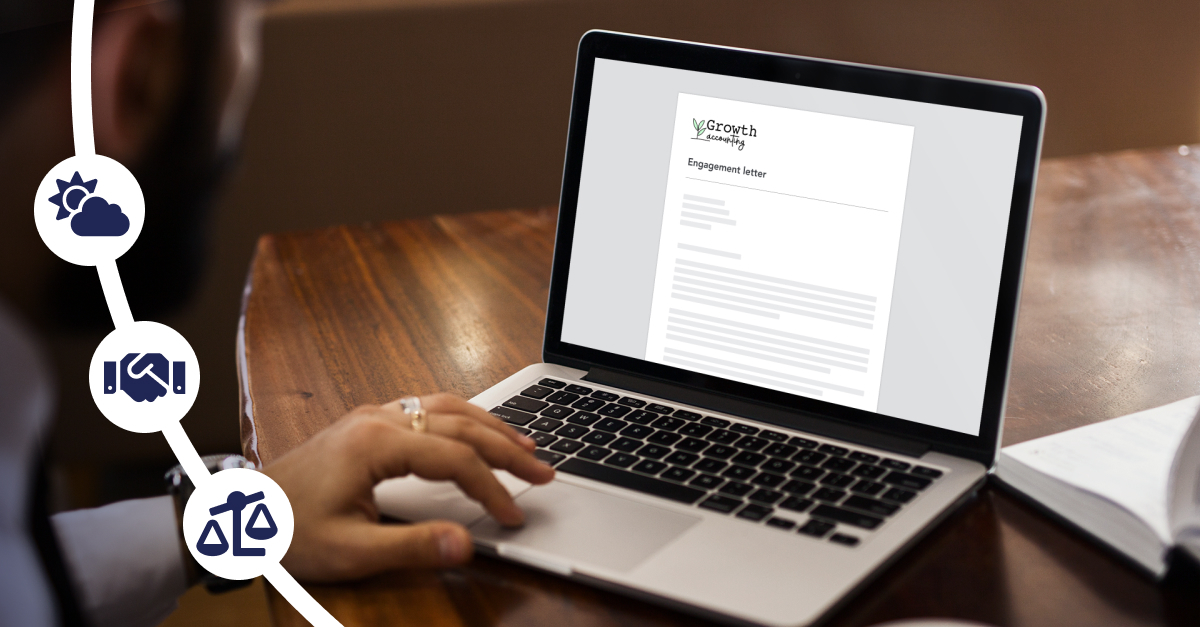Engagement letters: why they're important and what to include (with 12 samples)

Many people see engagement letters as a burden and a waste of time. That’s the wrong mindset to have.
Engagement letters are an important tool that smart practices use to grow their business while mitigating risk.
In this article we're going to walk you through why they're so important, what you should include in yours and share a few samples.
We'll also show you tips to fully automate your engagement process using Ignition.
The importance of engagement letters
Engagement letters define the business contract between a professional firm and its clients. It outlines the fee structure, responsibilities and obligations of the firm and the client. Without it, each party can be in legal limbo.
While verbal contracts are legally binding, they are notoriously difficult to enforce. Just agreeing on something won’t necessarily hold up in court if it comes to that.
They serve a bigger purpose than just business contracts though:
Engagement letters help you set expectations.
Engagement letters also help lay a solid foundation for a working relationship between a practice and their clients. They ensure transparency and demonstrate professionalism from the get-go.
Engagement letters reduce scope creep.
When you’ve set expectations with your client and clearly laid out what’s included with your services, you’ll reduce scope creep. You can also specify how you will proceed if the client needs more work done.
Engagement letters help you reduce risk.
Using engagement letters can help reduce professional liability insurance (or E&O insurance) premiums and many insurers require it. If insurers require them, then engagement letters must reduce liability and risk of doing business.
That makes it prudent to have engagement letter templates than your practice uses when onboarding new clients. They allow your practice to grow while limiting exposure to potential litigation.
How do I get an engagement letter?
Further down in this post we give you plenty of examples of engagement letters. Feel free to browse through them and find one that fits your needs.
You can use our recommendations and the samples below to build your engagement letter templates.
That being said, every case will be different. Always have an attorney look over your engagement letters before you put them in use.

What to include in your engagement letter
Luckily, here at Ignition we have access to a slew of different engagement letters from practices all over the world. We’ve analyzed over 100 engagement letters and found that the majority have the following sections:
Keep it simple.
The most effective engagement letters we have on the Ignition platform use a stand alone terms-and-conditions document that they reference within the engagement letter. This shortens the engagement letter, which makes it more approachable to clients.
See Interactive Accounting’s terms and conditions as an example. They reference their terms-and-conditions page from within their engagement letter. When the client agrees to the engagement letter, they also agree to the terms and conditions.
Think about including the following sections in your terms-and-conditions as opposed to your engagement letter:
- Billing practices (including your terms for late payment)
- Alternative dispute resolution
- Withdrawal provisions
- Limitations of liability
- Intellectual property, ownership of data and data protection
- Confidentiality agreement
- Privacy policy
Now that we’ve covered terms-and-conditions, here are the sections that most engagement letters include:
1. Identification
You should properly identify who will receive your services. It may be an individual, a group, an entity, or a portion of an entity – it’s important to specify.
Example
John Matthews
1027 42nd Street, Manhattan, New York City, 10036
Dear John,
This letter is to confirm our understanding of the terms of our engagement and the nature and limitations of the services that we provide.
Ignition tips for client identification:
- Specify the client’s name with {{ client.name }}
- Include the client’s address with {{ client.address }}
- Specify the client’s preferred {{ contact.salutation }}
2. Scope of services
Scope of services is probably the most important part of the entire engagement letter. By including your scope of services you help mitigate scope creep and guards against the client developing unreasonable expectations about the services to be performed.
Be very clear with what your services include.
Example
Service: Ledger Conversion, Setup and Training
We will setup a brand new Xero account for the entity named above. In this setup service:
- We will create and configure your chart of accounts
- We will convert your data from your existing accounting system to bring in your historical balances, contacts, payroll, sales and payable invoices.
- We will setup (up to 3) data feeds for your entities' bank and credit accounts and create automated bank rules for easy reconciliation of your transactions.
- We will customize up to 5 reporting templates for your business. *Configuration of additional reports can be purchased separately.*
- We will Review and suggest appropriate additional software to increase efficiency in your accounting and bookkeeping.
- We will provide 2 x 2 hour online training sessions (up to 5 team members per session).
- We will record and deliver your training sessions via our hosted Vimeo channel (password protected).
Please note: Your subscription to Xero is not included in the scope of this service.
Terms of Service:
- If data in your previous system is not ready for conversion, you will be requested to have our team review the data and correct the errors before the migration is started. This will require extra service and you will be provided with a new engagement and charged separately unless otherwise stated.
- The data is required to be provided at least 14 days prior to go live date to ensure there are no issues. Should this not occur, you may be sent an updated engagement with additional fees for “rush conversion”.
Ignition tips for scope of services:
- Include a summary of the services added to the proposal with {{ proposal.service_summary }}
- Include your terms for each service added to the proposal with {{ proposal.service_terms }}
3. Period of engagement
Specify when the engagement will begin and end. You can also include expected delivery dates if there’s a specific deliverable (ex. an audit).
Example
This engagement starts on February 1st, 2018 and is valid until February 1st, 2019. We will not deal with earlier periods unless you specifically ask us to do so and we agree.
Ignition tips for period of engagement:
- Add a start date with {{ proposal.commencement_date }}
- Include the end date with {{ proposal.end_date }}
4. Fee structure
Detail how much and how often the client will be billed. It’s advisable to also add in what will happen should the client request extra services not covered by the engagement letter
You may include a clause that specifies what happens in the case of late payment. It can be a late fee or suspension of service.
Example
On Acceptance
Ledger Conversion, Setup and Training - $2,000
Monthly Recurring
Monthly Bookkeeping - $800/month
All prices are inclusive of tax.
The fee arrangement is based on the expected amount of time and the level of staff required to complete the services as agreed. The fee excludes miscellaneous expenses which are incurred to complete the engagement.
Should the client need extra services not included in this engagement we bill at a rate of $150 per hour (subject to approval by *practice name*).
Ignition tips for fee structure:
- Include a price summary which breaks down your services by billing type with {{ proposal.price_summary }}
- Output the total on acceptance value with {{ proposal.on_acceptance }}
- Output the total on completion value with {{ proposal.on_completion }}
- Output the total recurring amount with {{ proposal.recurring }}
- Output the total cost with {{ proposal.total_cost }}
5. Responsibilities
In most engagements, the client is responsible for specific actions and to provide certain information or records. Be specific with what the client’s responsibilities are and state what information you are relying on the client for in order to fulfill the service.
Example
The Client is responsible for the reliability, accuracy and completeness of the accounting records, particulars and information provided and disclosure of all material and relevant information. Clients are required to arrange for reasonable access by us to relevant individuals and documents, and shall be responsible for both the completeness and accuracy of the information supplied to us. Any advice given to the Client is only an opinion based on our knowledge of the Client's particular circumstances.
A taxpayer is responsible under self assessment to keep full and proper records in order to facilitate the preparation of a correct return. Whilst the Commissioner of Taxation will accept claims made by a taxpayer in an income tax return and issue a notice of assessment, usually without adjustment, the return may be subject to later review. Under the taxation law such a review may take place within a period of up to [ ] years after tax becomes due and payable under the assessment. Furthermore, where there is fraud or evasion there is no time limit on amending the assessment. Accordingly, you should check the return before it is signed to ensure that the information in the return is accurate.
6. Professional standards
Refer the professional standards which govern the engagement. This varies depending on your location (ex. it may be the Professional Standards Authority if you’re in the UK or the Professional Standards Council if you’re in Australia).
Example
The conduct of this engagement in accordance with the standards and ethical requirements of *insert ruling body* means that information acquired by us in the course of the engagement is subject to strict confidentiality requirements, in addition to our obligations under the *insert confidentiality act*.
That information will not be disclosed by us to other parties, without your express consent, except as required by law or professional obligation.
7. Confirmation of terms
The bottom of your engagement letter should include the confirmation of terms which verifies that the client understands the business contract.
Example
I/We hereby accept the terms of your engagement letter.
Signed:
Full name:
Ignition tips for confirmation of terms:
- Include the client’s signature at the bottom of the engagement letter with {{ signature.client }}
- Include your signature and name inline on an accepted proposal with {{ "Your Name" | signature }}
Sample engagement letters
We've collected a number of sample engagement letters from various countries that practices are using with their clients.
Just know that we don’t personally endorse any of these examples. They are simply samples that we found around the web. Use at your own risk:
Engagement letters for Australia & New Zealand
Tax engagement letter (AU & NZ)
This is the engagement letter that McCarthy Accountants use for their individual income tax return clients: McCarthy Group's tax client engagement letter.
CPA Engagement Letter (AU & NZ)
This is the general engagement letter that CPA Australia gives to its members. It doesn’t include specific service terms but is a great starting point for any Australian CPA firm: CPA Australia's general engagement letter.
Audit Engagement Letter (AU & NZ)
This is a general example of an audit engagement letter by the Chartered Accountants of Australia & New Zealand: CAAN's sample audit engagement letter.
Bookkeeping Engagement Letter (AU & NZ)
The Institute of Certified Bookkeepers recommends the following template for their members. It includes service terms for bookkeeping services, payroll, BAS and more: ICB's bookkeeping engagement letter.
Engagement letters for Canada
Tax engagement letter (CA)
Lott & Company Professional Corporation uses the following engagement letter for their personal tax clients in Canada: Lott & Company's tax engagement letter.
CPA Engagement Letter (CA)
Cardy Winters & Simon LLP is a CPA firm and uses this template for their tax clients: CWS's CPA engagement letter.
Audit Engagement Letter (CA)
This is a sample engagement letter that KMPG used for an audit: KPMG Canada audit engagement letter.
Bookkeeping Engagement Letter (CA)
Madan Chartered Accountant uses this simple engagement letter with their bookkeeping clients: Madan CA's bookkeeping engagement letter.
Engagement letters for the United Kingdom
Tax engagement letter (UK)
This is the engagement letter template that Mackenzies Chartered Accountants uses with their personal tax return clients. They have their terms-and-conditions attached at the bottom as well: MK Chartered tax engagement letter.
General Engagement Letter (UK)
iPlan is a firm lead by Chartered Accountants that provides accounting services to owner managed businesses and this is the template that they use: iPlan's general engagement letter template.
Audit Engagement Letter (UK)
TWP Accounting LLP uses this engagement letter template when they provide auditing services to a client: TWP's audit engagement letter.
Bookkeeping Engagement Letter (UK)
The UK chapter of the Institute of Certified Bookkeepers recommends the following bookkeeping engagement letter: ICB's UK bookkeeping engagement letter.
Engagement letters for the United States
Tax engagement letter (USA)
Thompson Flaherty are a CPA firm & tax consultants based in Illionois who use the following template for their tax engagements: Thompson Flaherty's tax engagement letter.
CPA Engagement Letter (USA)
Erwin CPA group uses this general engagement letter with their corporate clients: Erwin CPA engagement letter.
Audit Engagement Letter (USA)
AccountantsWorld provides cloud solutions for US based accountants and this is the audit engagement letter they recommend: AccountantsWorld audit engagement letter.
Bookkeeping Engagement Letter (USA)
Barlow Halls & Douglas CPAs use this simple and effective bookkeeping engagement letter with their clients: Barlow Halls & Douglas bookkeeping engagement letter.



